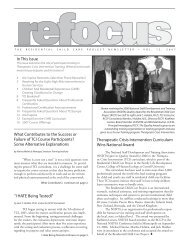The Therapeutic Crisis Intervention System - Residential Child Care ...
The Therapeutic Crisis Intervention System - Residential Child Care ...
The Therapeutic Crisis Intervention System - Residential Child Care ...
You also want an ePaper? Increase the reach of your titles
YUMPU automatically turns print PDFs into web optimized ePapers that Google loves.
Farragher, 2002; Hellerstein et al., 2007; Huckshorn,<br />
2006; J. A. Miller et al., 2006; Murphy & Bennington-<br />
Davis, 2005; NASMHPD, 2003; Paterson et al., 2008;<br />
Petti et al., 2003; Stefan & Phil, 2006). Organizations<br />
that decrease use of restraints can have positive child<br />
outcomes (Glisson, Dukes, & Green, 2006).<br />
By providing sufficient resources including adequate<br />
and qualified staff, support for regular external and<br />
internal monitoring, and clear rules and procedures<br />
that have safeguards against abusive practices,<br />
leadership promotes positive programming and an<br />
organizational culture to sustain the therapeutic<br />
milieu.<br />
Clinical participation. Clinical services play<br />
an important role in overseeing and monitoring<br />
children’s responses to crises. Developing and<br />
implementing an individual crisis management plan<br />
(ICMP) is critical to responding appropriately and<br />
therapeutically to a young person in crisis (Bullard<br />
et al., 2003; Carter et al., 2008; CWLA Best Practice<br />
Guidelines, 2004; Donat, 1998, 2005; Farragher, 2002;<br />
Hellerstein et al., 2007; Huckshorn, 2006; Murphy &<br />
Bennington-Davis, 2005; NASMHPD, 2003; Nunno<br />
et al., 2003; Paterson et al., 2008; Salias & Wahlbeck,<br />
2005; Stefan & Phil, 2006). <strong>The</strong>se plans are most<br />
effective when developed with input from team<br />
members and the child and the child’s family, and are<br />
written in clear and concise language so that the care<br />
staff can implement the plan.<br />
At intake, a risk assessment of the child’s propensity<br />
to engage in high-risk behaviors and the conditions<br />
that have provoked these behaviors in the past can<br />
provide valuable information. Key questions to<br />
address are: (a) How can high-risk behaviors be<br />
prevented? (b) Is there a need for an ICMP? (c) What<br />
intervention strategies should be used if an ICMP is<br />
necessary?<br />
Well-developed ICMPs include strategies for<br />
preventing, de-escalating, and managing potential<br />
high-risk behavior specific to the child. Included<br />
in the plan are specific physical interventions, if<br />
appropriate, or alternative strategies if physical<br />
intervention is not an option. It is important to<br />
TCI SYSTEM IMPLEMENTATION: Implementation Criteria<br />
screen all young people in care for any pre-existing<br />
medical conditions that would be exacerbated<br />
if the young person were involved in a physical<br />
restraint. Any medications that the young person<br />
may be taking which would affect the respiratory<br />
or cardiovascular system should also be noted. If<br />
there is a history of physical or sexual abuse that<br />
could contribute to the young person experiencing<br />
emotional trauma during a physical restraint, it is<br />
equally important to document this in the plan.<br />
Ongoing reviews of the young person’s crisis plan<br />
with revisions as the child’s condition changes will<br />
help staff develop more effective ways to prevent and<br />
intervene with the child’s high-risk behaviors.<br />
Supervision and post crisis response. Frequent<br />
and ongoing supportive supervision, mentoring, and<br />
coaching are essential for creating and sustaining<br />
an organization’s ability to reduce the need for<br />
restraint and maintain good quality care (Bullard<br />
et al., 2003; Colton, 2008; CWLA Best Practice<br />
Guidelines, 2004; Donat, 1998, 2005; Farragher, 2002;<br />
Huckshorn, 2006; J. A. Miller et al., 2006; Murphy<br />
& Bennington-Davis, 2005; NASMHPD, 2003;<br />
Nunno et al., 2003; Petti et al., 2003; Ryan, Peterson,<br />
Tetreault, & van der Hagen, 2008; Thompson et al.,<br />
2008). Reflective and supportive supervision is built<br />
into the implementation and ongoing monitoring<br />
of the TCI crisis management system. Supervisors<br />
who are fully trained in all of the prevention, deescalation,<br />
and intervention techniques can provide<br />
effective supervision, coaching, and monitoring<br />
of their staff members. Fully trained and effective<br />
supervisors have reasonable expectations with realistic<br />
time frames and schedules for staff so that staff can<br />
accomplish tasks and respond to young people’s needs<br />
in a thoughtful and well-planned manner.<br />
This post crisis response system ensures that all young<br />
people and staff receive immediate support and<br />
debriefing following a crisis as well as a brief medical<br />
assessment (Bullard et al., 2003; CWLA Best Practice<br />
Guidelines, 2004; Farragher, 2002; Huckshorn, 2006;<br />
J. A. Miller et al., 2006; Murphy & Bennington-Davis,<br />
2005; NASMHPD, 2003; Nunno et al., 2003; Petti<br />
et al., 2003). Once things are back to normal, all staff<br />
members involved in the restraint can deconstruct<br />
THERAPEUTIC CRISIS INTERVENTION SYSTEM: <strong>Residential</strong> <strong>Child</strong> <strong>Care</strong> Project, Cornell University 17



